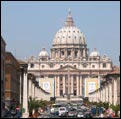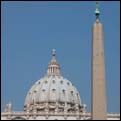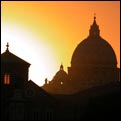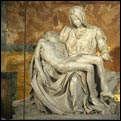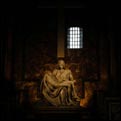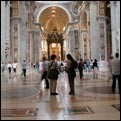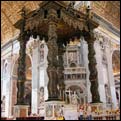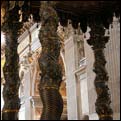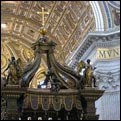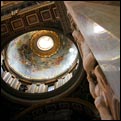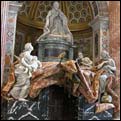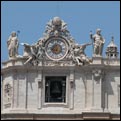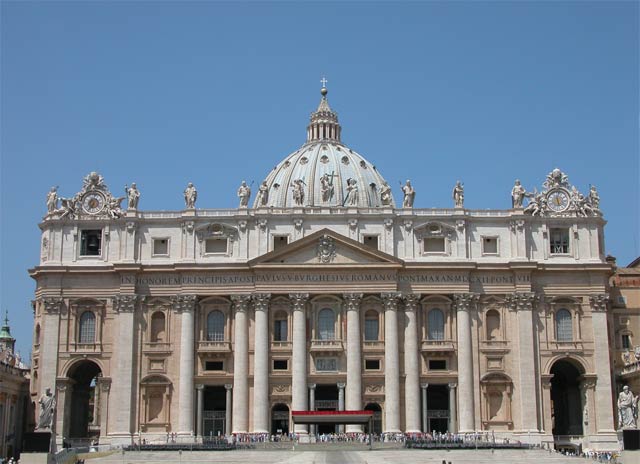
The Basilica of St. Peter was the first and noblest religious edifice erected by Constantine. It stood on part of the circus of Nero, and was supposed to occupy a spot consecrated by the blood of numberless martyrs, exposed or slaughtered in that place of public amusement, by order of the tyrant. But its principal and exclusive advantage, was the possession of the body of St. Peter; a circumstance which raised it in credit and consideration, above the Basilica Laleranensis, dignified its threshold with the honourable appellation of the Limina Apostolorum (the threshold of the Apostles), and secured to it the first place in the affection and reverence of the Christian world. Not only monks and bishops, but princes and emperors visited its sanctuary with devotion, and even kissed, as they approached, the marble steps that led to its portal. Nor was this reverence confined to the orthodox monarchs who sat on the throne of the founder; it extended to barbarians, and more than once converted a cruel invader into a suppliant votary.
The vandal Genseric, whose heart seldom felt emotions of mercy, while he plundered every house and temple with unrelenting fury, spared the treasures deposited under the roof of the Vatican Basilica, and even allowed the plate of the churches to be carried in solemn pomp to its inviolable altars. Totila, who, in a moment of vengeance, had sworn that he would bury the glory and the memory of Rome in its ashes, listened to the admonitions of the Pontiff, and resigned his fury at the tomb of the Apostles.
Every age, as it passed over the Vatican, seemed to add to its holiness and its dignity, and the coronation of an Emperor, or the installation of a Pope, the deposition of the remains of a prince, or the cnshrinement of the reliques of a saint, appeared as so many tributes paid to its supereminence. and gave it so many new claims to the veneration of the Christian world. At length, however, after eleven centuries of glory, the walls of the ancient Basilica began to give way, and symptoms of approaching ruin were become so visible about the year 1450, that Nicholas V. conceived the project of taking down the old church, and erecting in its stead a new and more extensive structure. However, though the work was begun, yet it was carried on with feebleness and uncertainty during more than half a century, till Julius II. ascended the Papal throne, and resumed the great undertaking with that spirit and decision which distinguished all the measures of his active pontificate. Great princes generally find or create the talents requisite for their purposes, and Julius discovered in Bmmante, an architect capable of comprehending and executing his grandest conceptions. A plan was presented and approved. The walls of the ancient Basilica were taken down, and on the 18th of April, 1508, the foundation stone of one of the vast pillars that support the dome, was laid by Julius, with all the pomp and ceremony that became such an interesting occurrence. From that period the work, though carried on with ardor and perseverance, yet continued during the space of one hundred years, to occupy the attention and absorb the income of eighteen Pontiffs. I might have augmented this number, by the addition of the names of Urban VIII., Alexander VII. and their successors, down to Benedict XIII. who all contributed to the erection, embellishment, and completion, of the superb colonnade that opens before the church, and adds so much to its majesty. The Popes who have since followed have not been entirely inactive, but have endeavoured, each according to his ability, to acquire a share in the glory and duration of this edifice, by some decoration or improvement. In fine, the late Pius VI. built the sacristy, and by this very necessary appendage, which had till then been wanting, may be considered as having accomplished the grand undertaking, and given the Basilica Vaticana its full perfection.
On the whole, it would not be exaggeration to assert, that nearly 300 years elapsed, and 35 Pontiffs reigned, from the period of the commencement to that of the termination of this stupendous fabric. The most celebrated architects of modern times, had an opportunity of displaying their talents and immortalizing their names in the prosecution of the work, and Bramante, Raffaello, San Gallo, Michael Angelo, Vignola, Carlo Maderno, and Bernini, not to speak of others of less reputation, labored successively in its promotion or consummation. To calculate the expence with any great precision would be difficult, but from the best information that has been collected on the subject, we may venture'to state that, however enormous the sum may appear, the expenditure must have amounted at least to 12 millions sterling; and when we consider that the marbles, bronze, and other valuable materials employed in its decoration, are not only uncommon, but scarcely known out of Rome, we may add that it would require three times as much to raise a similar edifice in any other capital.
From the bridge and Castel de St. Angelo, a wide street conducts in a direct line to a square, and that square presents at once the court or portico, and part of the Basilica. When the spectator approaches the entrance of ihis court, he views four rows of lofty pillars, sweeping off to the right and left in a bold semicircle. In the centre of the area formed by this immense colonnade, an Egyptian obelisk, of one solid piece of granite, ascends to the height of 130 feet; two perpetual fountains, one on each side, play in the air, and fall in sheets round the basins of porphyry that receive them. Before him, raised on three successive flights of marble steps, extending 400 feet in length, and towering to the elevation of 180, he beholds the majestic front of the Basilica itself. This front is supported by a single row of Corinthian pillars and pilasters, and adorned with an attic, a balustrade, and thirteen colossal statues. Far behind and above it rises the matchless dome, the justly celebrated wonder of Rome and of the world. The colonnade of coupled pillars that surround and strengthen its vast base, the graceful attic that surmounts this colonnade, the bold and expansive swell of the dome itself, and the pyramid seated on a cluster of columns, and bearing the ball and cross to the skies, all perfect in their kind, form the most magnificent and singular exhibition that the human eye perhaps ever contemplated.
The interior corresponds perfectly with the grandeur of the exterior, and fully answers the expectations, however great, which such an approach must naturally have raised. Five lofty portals open into the portico or vestibulum, a gallery, in dimensions and decorations, equal to the most spacious cathedrals. It.is 400 feet in length, 70 in height, and 50 in breadth, paved with variegated marble, covered with a gilt vault, adorned with pillars, pilasters, mosaic and basso relievos, and terminated at both ends by equestrian statues, one of Constantine, the other of Charlemagne. A fountain at each extremity supplies a stream sufficient to keep a reservoir always full, in order to carry off every unseemly object, and perpetually refresh and purify the air and the pavement Opposite the five portals of the vestibule are the five doors of the church; three are adorned with pillars of the finest marble; that in the middle has valves of bronze.
As you enter, you behold the most extensive hall ever constructed by human art, expanded in magnificent perspective before you; advancing! up the nave, you are delighted with the beauty of the variegated marble under your feet, and with the splendour of the golden vault over your head. The lofty Corinthian pilasters with their bold entablature, the intermediate niches with their statues, the arcades with the graceful figures that recline on the curves of their arches, charm your eye in succession as yon pass along. But how great your astonishment when you reach the foot of the altar, and standing in the centre of the church, contemplate the four superb vistas that open around you; and then raise your eyes to the dome, at the prodigious elevation of 400 feet, extended like a firmament over your head, and presenting, in glowing mosaic, the companies of the just, the choirs of celestial spirits, and the whole hierarchy of Heaven arrayed in the presence of the Eternal, whose "throne high raised above all height" crowns the awful scene.
The high altar stands under the dome, and thus as it is the most important, so it becomes the most striking object . In order to add to its relief, and give it all its majesty, according to the ancient custom still retained in the patriarchal churches at Rome, and in most of the cathedrals in Italy, a lofty canopy rises above it, and forms an intermediate break or repose for the eye, between it and the immensity of the dome above. The form, materials, and magnitude of this decoration are equally astonishing. Below the steps of the altar, and of course some distance from it, at the corners, on four massive pedestals, rise four twisted pillars, fifty feet in height, and support an entablature which bears the canopy itself, topped with a cross. The whole soars to an elevation of 13a feet from the pavement, and excepting the pedestals is of Corinthian brass! the most lofty massive work of that or of any other metal now known. But this brazen edifice, for so it may be called, notwithstanding its magnitude, is so disposed as not to obstruct the view by concealing the chancel and veiling the Cathedral or Choir of St. Peter. The choir is a lofty throne, elevated to the height of 70 feet from the pavement; a circular window, tinged with yellow, throws from above a milder splendour around it, so that the whole not unfitly represents the pre-eminence of the Apostolic See, and is acknowledged to form a most becoming and majestic termination to the first of Christian temples.
The History of the Church and Court of Rome from the Establishment of ... Di Hallifield C. O'Donnoghue - 1830

